Rzeszów 2023-11-29
Rzeszów Główny railway station.
Geographic coordinates: 50.043N 22.006E. Elevation 200 m. The station was always called Rzeszów, except during World War II, when the Germans used the name Reichshof. On December 14, 2008, the name of the station was changed to Rzeszów Główny. In 2011, the station served approximately 4,820 passengers per day. In 2017, 6,600 passengers per day. In 2018, 7,400 passengers. In 2019, 8,600 passengers. In 2021, 7,400 passengers. In 2022, 12,000 passengers.
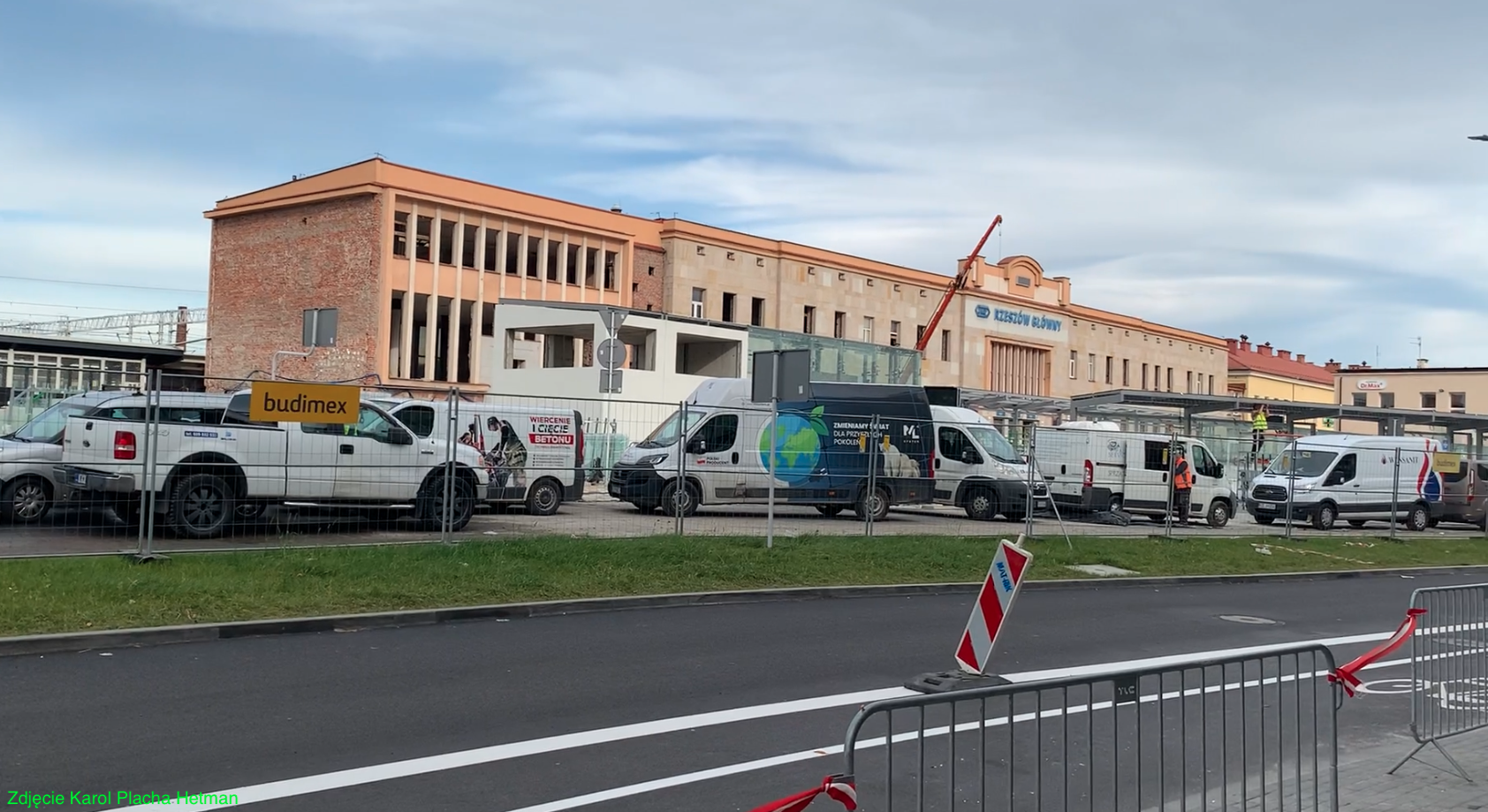
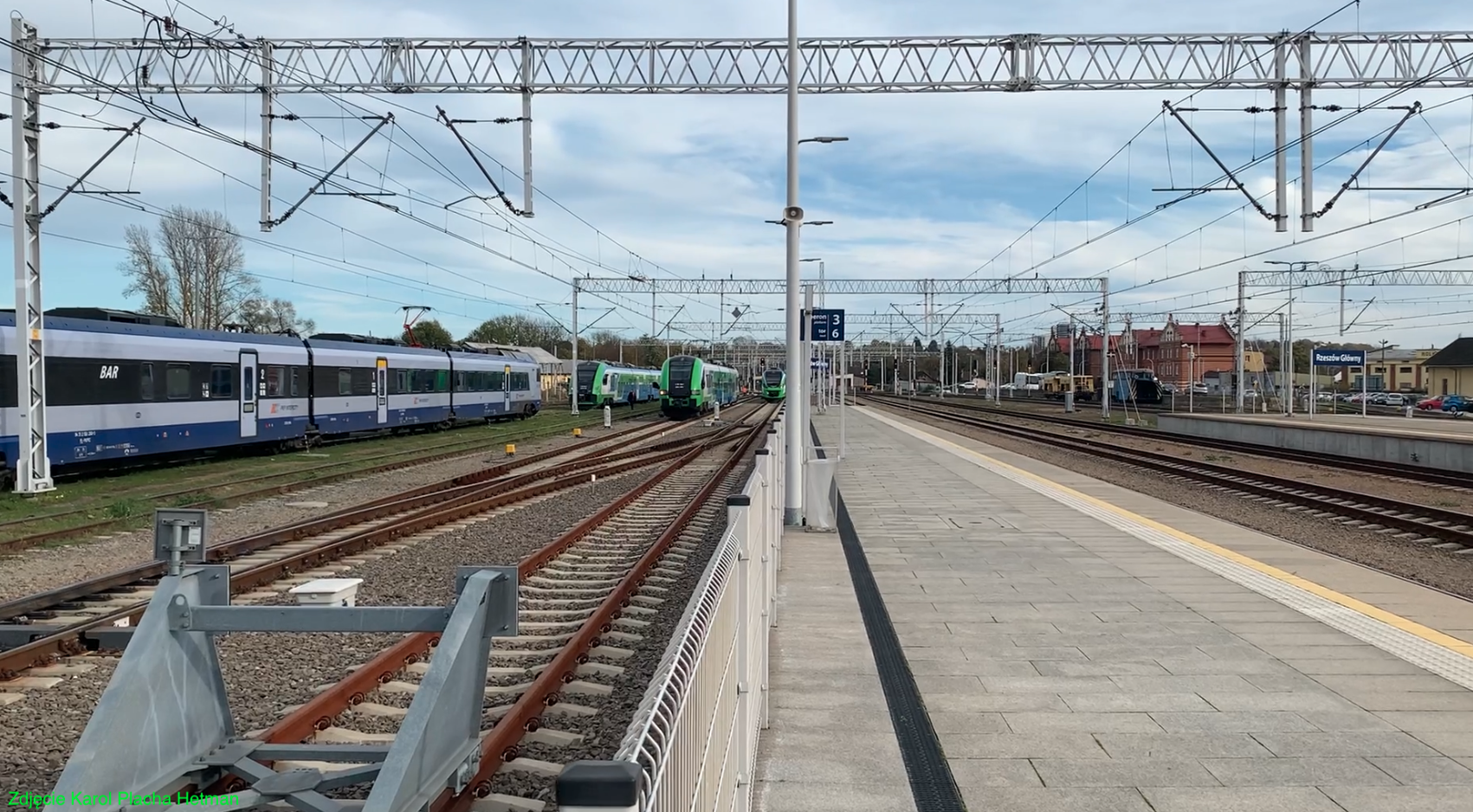
Photo description: View towards Przemyśl. On the right you can see the buildings of the Railway Directorate.
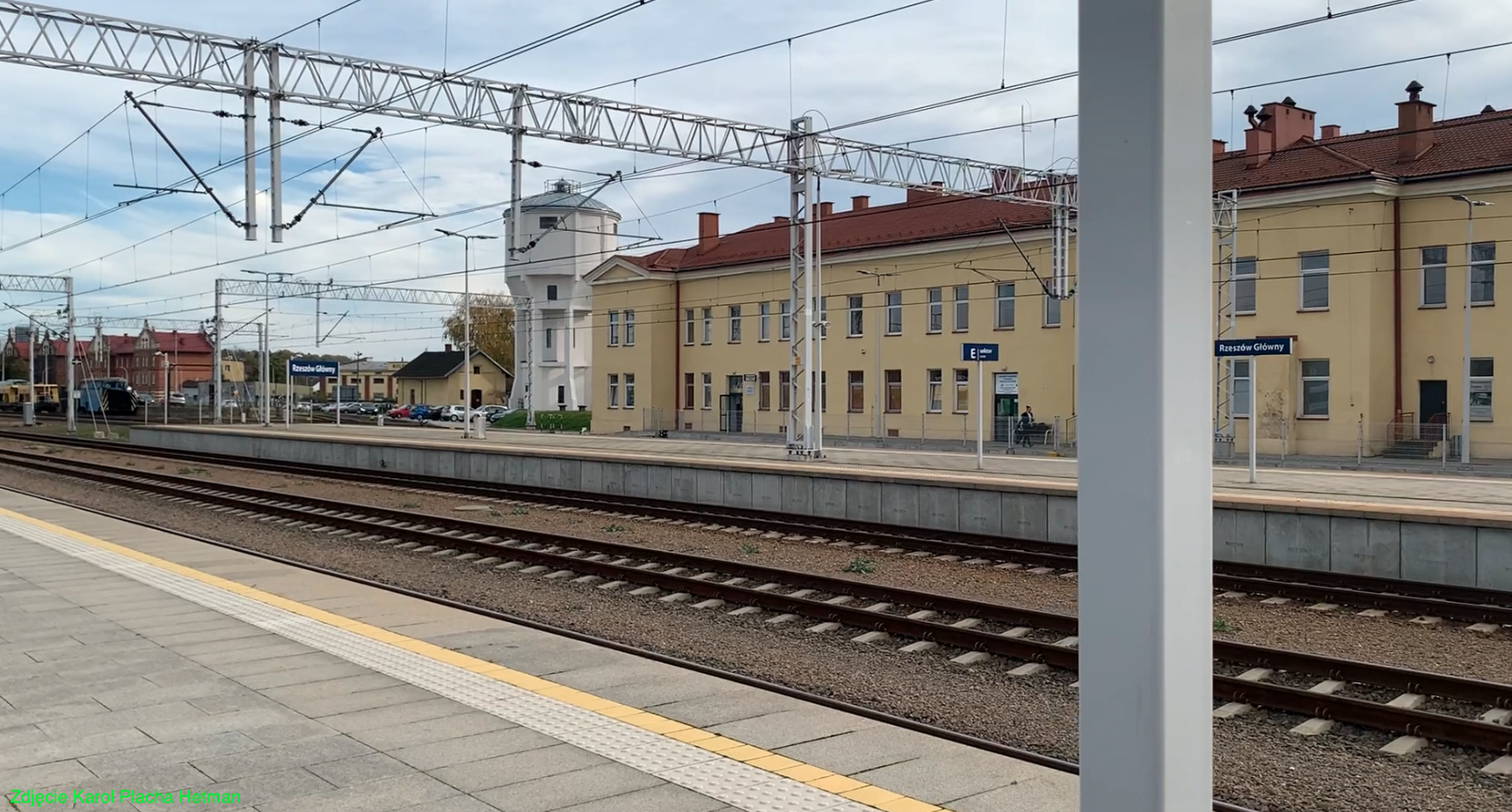
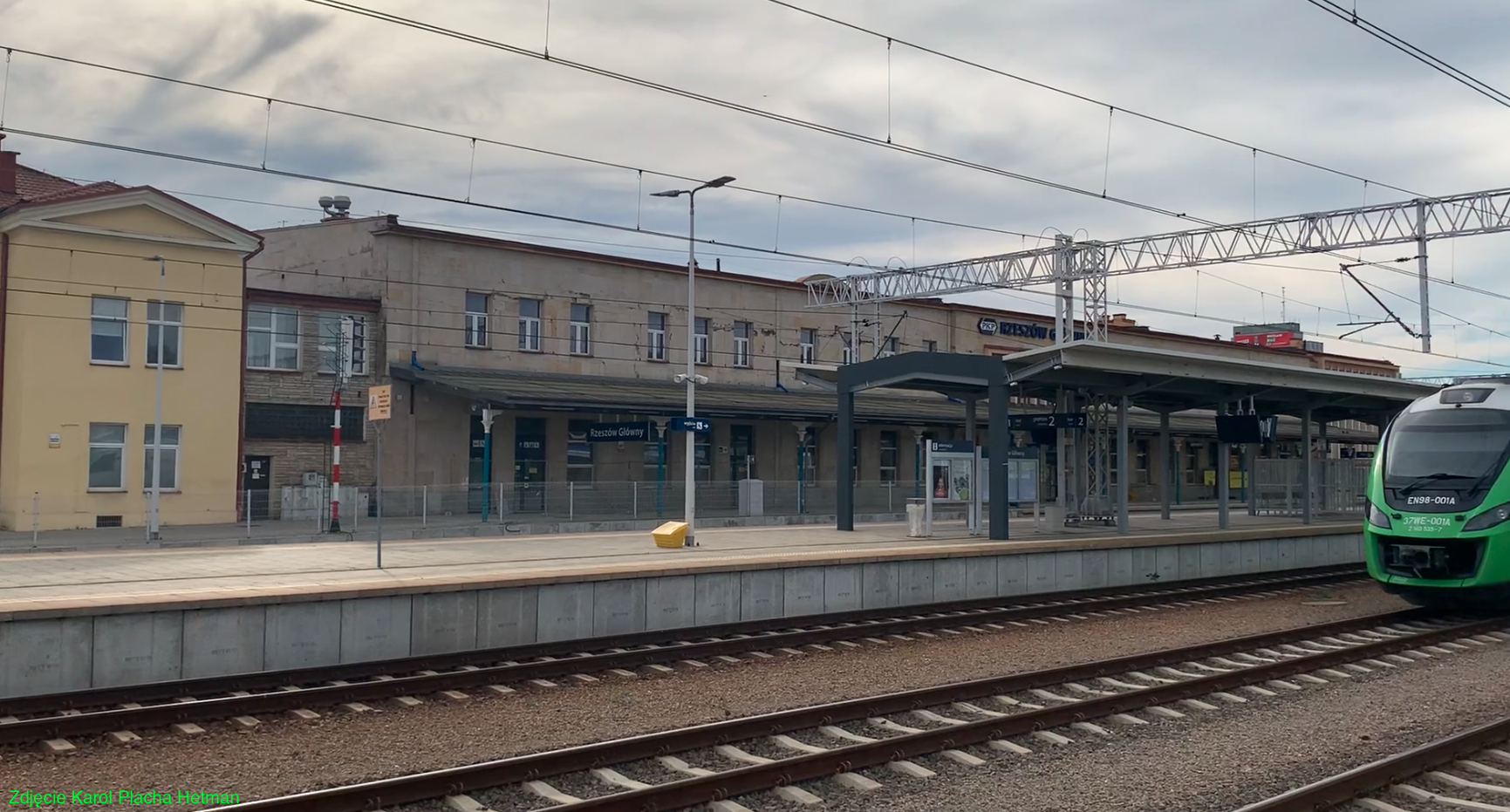
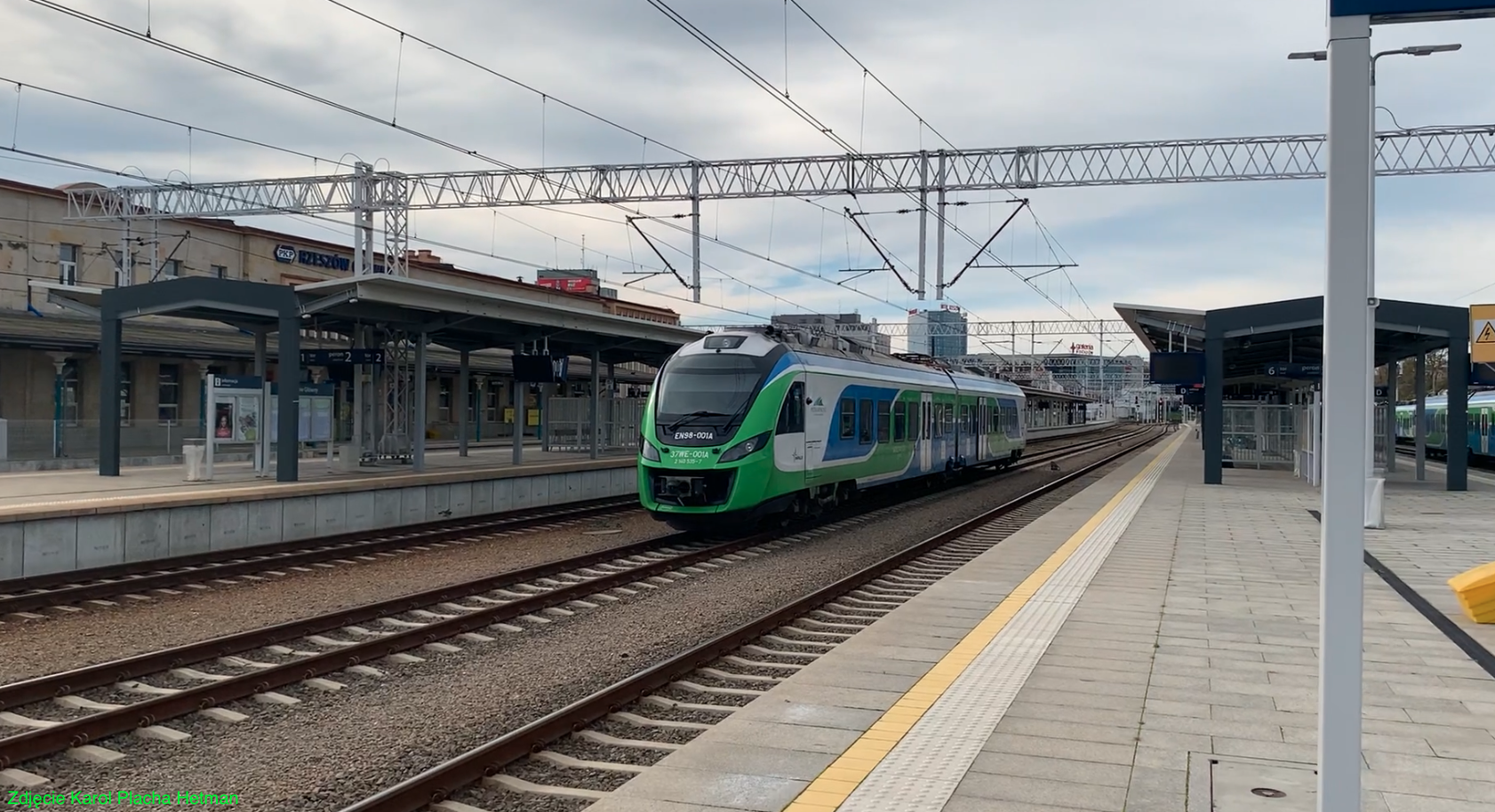
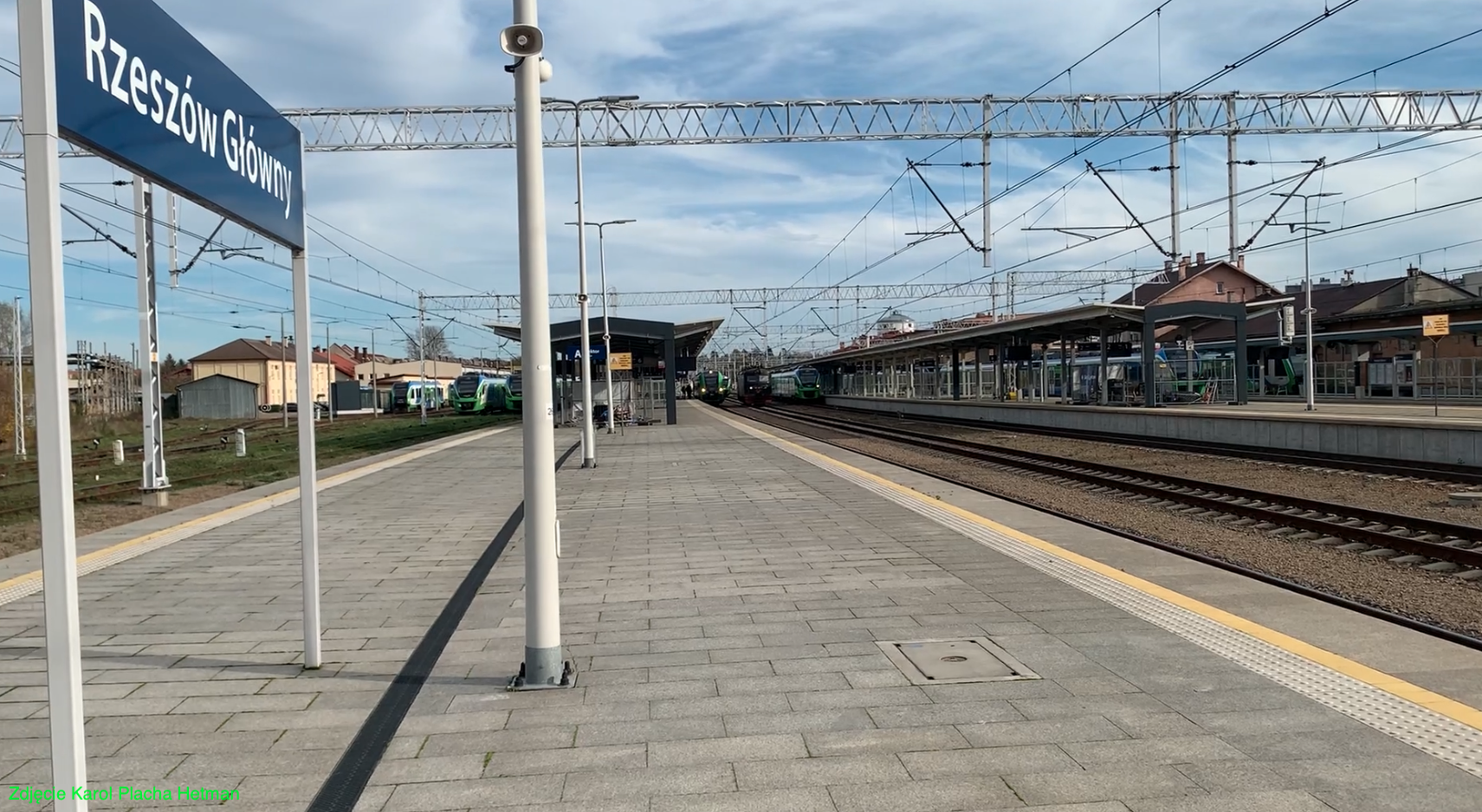
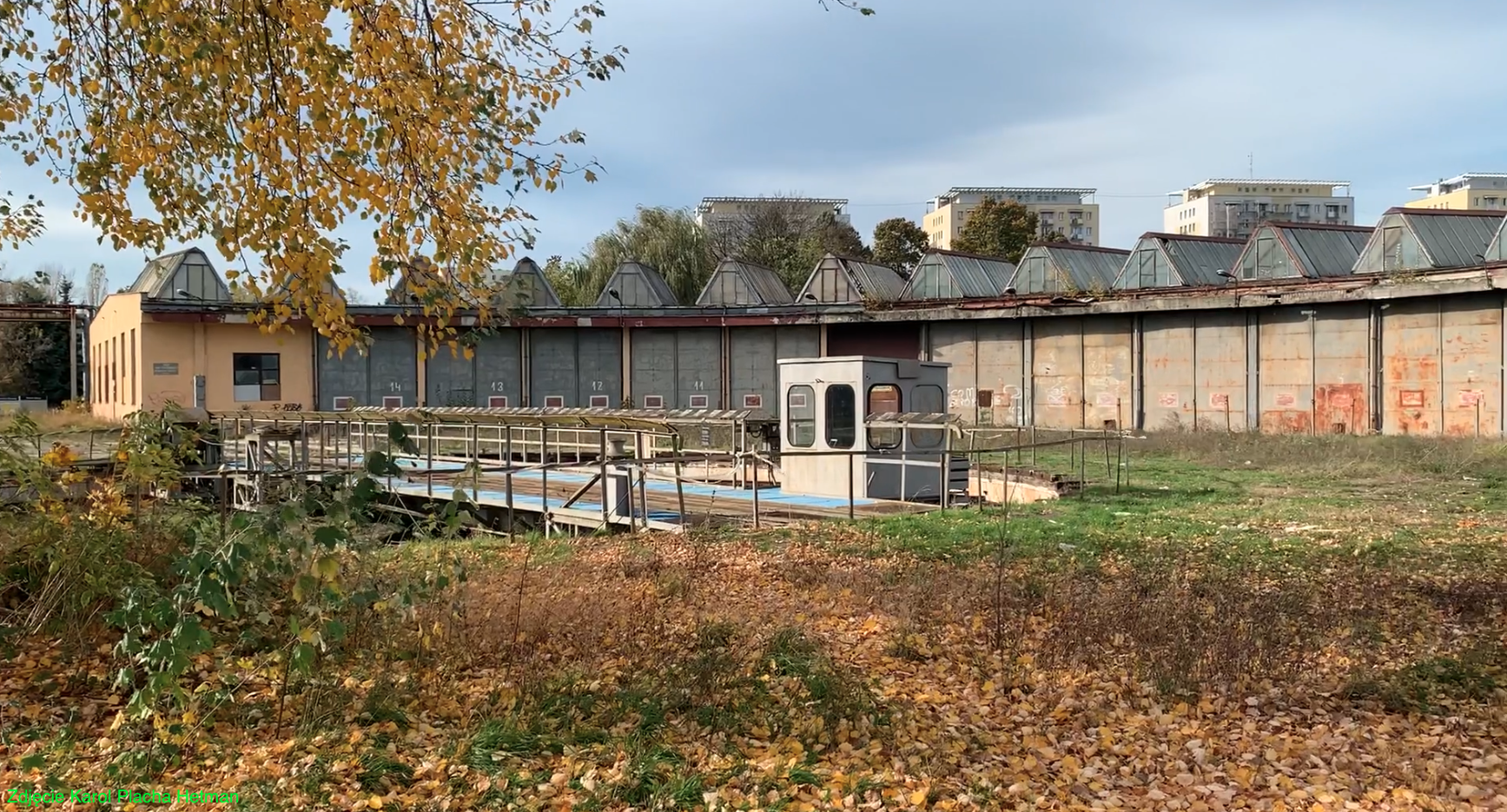
City of Rzeszów.
Rzeszów is a city in south-eastern Poland, which is the capital of the Podkarpackie Voivodeship. The city belongs to the Rzeszów agglomeration. Currently, the city has an area of 129.01 square kilometers. The city's population in 2023 was 197,536 inhabitants, which placed it 14th in Poland. Rzeszów is located on the Wisłok River, on the border of the Sandomierska Valley and the Central Beskid Foothills. The city extends in elevation ranging from 197 m above sea level. up to 384 m above sea level.
Distance from Rzeszów to: Tarnów is 86 km, Kraków is 168 km, Przemyśl is 80 km, Lviv is 170 km, Sandomierz is 87 km, Warsaw is 330 km. Rzeszów's infrastructure includes the International Airport in Jasionka.
The settlement that later became the city of Rzeszów was founded in the 11th century. City rights were granted on January 19, 1354, by King Casimir the Great. In 1633, Rzeszów obtained the right to store. After the first partition of Poland in 1772, Rzeszów became part of the Austro-Hungarian monarchy. From 1869, Rzeszów functioned in the established Galicia. After Poland regained independence in 1918, Rzeszów found itself in the Lviv Voivodeship. Since 1945, Rzeszów has been the capital of the voivodeship (first the Rzeszów Voivodeship, and since 1999, the Podkarpackie Voivodeship).
Currently, Rzeszów is a large educational center. There is the University of Rzeszów, the Rzeszów University of Technology, the Higher School of Engineering and Economics, the WSPiA Rzeszów Higher School, the Higher School of Information Technology and Management and the Higher Theological Seminary. Rzeszów has the highest number of students per 1,000 inhabitants, which gives the city first place in Poland. In 2021, there were 48,000 students in Rzeszów.
The following Polish Army units are stationed in Rzeszów; 21st Podhale Rifle Brigade named after Brigadier General Mieczysław Boruta-Spiechowicz and 3rd Podkarpacka Territorial Defense Brigade named after colonel Łukasz Ciepliński. There is also the Provincial Military Staff in Rzeszów.
Railway transport.
The first plans for a railway connection between Rzeszów and Kraków were developed in 1829-1830. Traction was to be horse-drawn. Ultimately, the line was to connect Lviv - Vienna. The author of this concept was Franz Xaver Riepl, professor at the Vienna University of Technology. The motivating factor was the transport of salt from Bochnia and Wieliczka and hard coal from Silesia to Vienna. In 1936, a brochure was published for the project, which popularized the investments. The construction of the line was started by Emperor Ferdinand's Privileged Northern Railway (KFNB), but it only led to Oświęcim. The next route was completed by CK Wschodnia Kolej Państwowa.
Due to the terrain, the original route of the Kraków - Lviv railway line was to run approximately 5 km, north of Rzeszów, through the village of Zaczernie. However, protests from Rzeszów's councilors resulted in the line being drawn closer to the city, in the shape of the letter "U". The station was established in the town of Ruska Wieś, north of the center of Rzeszów.
The first train arrived in Rzeszów on November 15, 1858, in connection with the construction of the Galician Railway named after Charles Ludwik, when Poland was under partition. At that time, a 46.9 km long section, Dębica - Rzeszów, was put into operation. The contractor was the private company CK Privileged Galician Railway of Charles Louis (CLB). The line was part of the railway connecting Vienna with Krakow and Lviv. Construction lasted in the period 1856-1861. The next section Rzeszów - Przeworsk, 36.7 km long, was launched in 1859. Already on November 4, 1861, the line was passable along its entire length, i.e. to Lviv.
In 1891, the Krakow - Lviv line received a second track. The line was 244.3 km long.
At that time, CLB and kkStB were involved in disputes over the transportation of goods and the division of profits. The disputes ended when the CLB company was nationalized in 1892. This fact resulted in the Rzeszów Staroniwa station (kkStB) being connected with the Rzeszów Główny station (CLB) by a slip road.
In 1938, the Rzeszów Osiedle railway stop was opened, followed by the Zwięczyca and Załęże stops, whose names were changed after the city's administrative borders were expanded.
In the period 1959-1963, the line was electrified along its entire length. The main reason was the vassalization of Poland by the CCCP and the need to efficiently ship goods to the East and deliver raw materials to Poland.
Rzeszów Główny railway station.
In 1858, the Main Railway Station in Rzeszów was opened. The railway station in Rzeszów was then outside the administrative boundaries of the city. The station became part of the administrative boundaries of Maista in 1902. The station's considerable distance from the center of Rzeszów was not that bothersome. Around the station, there is a lot of free land where numerous warehouses, factories, craft workshops, trading companies, restaurants and hotels have been built.
On October 12, 1890, the Rzeszów Staroniwa station and the Rzeszów Główny - Strzyżów - Jasło railway line were opened. The line is single-track, 70.2 km long. The line is not electrified. As a result, the station in Rzeszów became a junction station. The creation of a railway junction in Rzeszów was a strong factor for the city, strengthening its economic development. This influenced the development of urban infrastructure and, above all, gave people good jobs. Thanks to this, Rzeszów became an important city in the future Central Industrial District.
In the first period, a locomotive shed was built on a rectangular plan at the station in Rzeszów. Workshop buildings were also built.
In 1908, the construction of a 2.5 m wide footbridge over the tracks for passenger traffic began.
In 1908, a railway and road crossing was built along the current Marszałkowska Street to facilitate communication between the southern and northern parts of the city. The crossing is equipped with barriers and a crossing guard's booth.
In 1910, taking advantage of the terrain, the first tunnel was built under the tracks, along what is now Stefana Batorego Street, in the eastern head of the station. Initially, it was just a culvert. The culvert was rebuilt into a street, paved and sewerage was installed. The walls of the slope were lined with stone cladding. The width of the tunnel was about 3 m and the height was about 2.8 m. These dimensions allowed horse-drawn carriages to pass freely. Staying ahead of the facts; over the following decades, transit became inefficient; low and tight. Therefore, in the period 2019-2021, a completely new viaduct was built. Under the viaduct there is a road with three lanes for cars, sidewalks for pedestrians on both sides of the road and a bicycle path. The sidewalks are accessible to wheelchair users and strollers.
The Rzeszów railway junction developed rapidly and employed more employees. For railway workers' families, a residential estate was built north of the station. Currently, it is a 1000th anniversary estate. In the future, a vocational railway school was opened for young people and already employed workers.
Around 1910, two buildings of the Railway Directorate were built on today's Stefana Batorego Street. The buildings were built in the neo-Gothic style and are still standing (2023). The buildings in the surroundings are distinguished by their size, characteristic shape and facades made of natural red and white brick. The buildings are three-story, and the outer wings extend to form avant-corps, which are topped with a superstructure.
Around 1910, a tunnel was also built under the platforms and tracks for passenger traffic. The passage is located west of the station building. A little later, a footbridge was built over the tracks, also in the area of the western head of the station. The difference between the tunnel and the footbridge was that the tunnel ended at Platform 3. However, the footbridge led all the way behind the station on its northern side. The footbridge was used by railway workers and residents. The footbridge was closed in 2022.
On November 18, 1918, at the request of the Warsaw Railway Directorate, the Ministry of Railways established the Railway Guard. A Railway Guard station was established at the station in Rzeszów. The Railway Guard was renamed the Railway Protection Guard. This service operates until now (2023).
The renovation of the Rzeszów Główny railway station and the Rzeszów Zachodni station began in August 2018. The amount of PLN 205 million was allocated for both tasks. The first stage of the renovation of the Rzeszów Główny station was completed in December 2020. The scope of work performed included; new platforms, extension of the passenger tunnel to Jan Kochanowski Street, demolition of the old footbridge on the platforms and tracks (between the station square and Jan Kochanowski Street). Finishing works in the tunnel were carried out in October 2023.
Rzeszów Główny Railway Station.
The station in Rzeszów was designed by the railway office in Vienna, like other stations in Galicia, belonging to the Charles Ludwig Railway. The building was designed on a rectangular plan, as a two-story building. It was covered with a gable roof, with an undeveloped attic. The station was put into operation on November 15, 1858, just 10 years after the Warsaw-Vienna Railway was launched in the Kingdom of Poland.
The first reconstruction of the station took place in 1889-1890. Then the roof was changed to a hipped one and at the same time it was lowered. The building received decorations reminiscent of Renaissance Florentine city palaces. This was the typical style of railway stations in Galicia at that time. A characteristic architectural element were three huge windows on the entrance door, both from the side of the station square and from the tracks. This arrangement meant that the main station hall was well lit. At that time, side single-story pavilions were added and covered with a three-slope roof. Inside the station there were ticket and baggage counters, waiting rooms for 1st and 2nd class passengers, a restaurant and service rooms. On the first floor there were apartments for the station master and the restaurateur.
The station underwent the next reconstruction in 1908, a few years before the outbreak of the Great World War. At that time, a new restaurant, waiting rooms for Class 3 passengers, and a roof over Platform 1 were built. The restaurants were located in the west wing, and the waiting rooms for Class 3 passengers in the east wing. The roof over the platform was made of decorative cast iron.
The lighting in the station square was changed from kerosene lanterns to gas lanterns. A small palace-type garden was established on the station square. The garden includes a decorative water pool, flower beds and trees of rare species. Horse-drawn carriages arriving in front of the station drove around the entire garden. Access to the station from the city center was through a street, currently Adama Asnyk Street, which was paved. It was a typical street, most of the houses were wooden and inhabited mainly by railway workers' families.
The railway station in Rzeszów was unlucky during both world wars. During the Great World War, the station building was destroyed by the retreating Moscow troops in 1915. During World War II, the station was destroyed by Germanic air raids (1939), and in 1944, again by retreating Germanic troops. The station was in the main directions of the armed attack. In both cases, the station was rebuilt. However, its original style has been preserved.
In the 1960s, the station was rebuilt in a modernist style. The idea was to adapt the facility to the changed needs of travelers and PKP. The number of ticket counters had to be increased, the waiting room had to be enlarged, toilets were rebuilt, and rooms for SOK and MO were created. Modern railway information was installed inside the hall. On the façade, the rustication, the cornice between the floors and other decorations were removed. The upper arches in the windows have been removed. All windows became rectangular. The building's façade was lined with sandstone slabs. There are large slit windows above the main entrances. The central part of the building with the entrances is a projection. The entire building is covered with a flat roof, hidden behind a large cornice.
In 2008, another renovation of the station building was carried out. Unfortunately, it was a time when Poland was ruled by Freemasonry, which had no money for anything, and there was a joyful festival of the liquidation of the Polish Railways. Therefore, the renovation was only partially completed. Many tasks from the work schedule were removed, with the suggestion "to be done in the future".
In 2010, the condition of the station was very bad and did not differ from other stations in Poland. The platforms were of the high type, with an asphalt surface. The surface needed renovation. The parking tracks were in poor technical condition and were not used. The fan locomotive shed was partially used by diesel locomotives. The carriage house was being renovated. It was the time of liquidation of the Polish Railways.
In 2021, the renovation of the station building began. The station was completely closed to passenger traffic. A temporary container station was assembled. In the spring of 2022, the comprehensive reconstruction of the station building began, along with the construction of an underground parking lot for over 100 passenger cars. Architectural barriers were completely eliminated.
In 2020, the railway station, bus station and adjacent facilities were transformed into the Rzeszów Communication Center. On February 7, 2021, an investment agreement for the construction of the center was signed. The complete reconstruction of the railway station, railway station and adjacent areas is scheduled to be completed in spring 2024. In 2023, the work was far advanced. In July 2023, the installation of a new dynamic passenger information system (screen) and station monitoring system began.
On November 28, 2023, it was officially announced that there would be a delay in the date of putting the station into operation. The new date is June 2024. Of course, Freemasonry launched a total criticism. Freemasonry cannot understand that the investment is very extensive, carried out by many companies, with constant railway, coach and public transport traffic. The investors are the city of Rzeszów and the railway companies PKP S.A. The scope of work has also increased. Work was also suspended due to the need to carry out archaeological work. In addition, Freemasonry shouts that the value of the investment increased from PLN 30 to PLN 75 million. Well, their fathers worked in social activities and only then, for the camera, did they hold shovels and rakes in their hands.
Rzeszów junction currently. 2023.
From December 13, 2015, the PKP InterCity carrier launched passenger transport on the route: Rzeszów Główny - Kraków Główny - Warszawa Centralna - Gdynia Główna, using Pendolino trains. Since March 2016, the InterCity and TLK carriers have increased the number of connections from Rzeszów to: Warsaw, Kraków, Wrocław, Poznań, Szczecin. Passenger trains leave from Rzeszów in four directions: northern (Tarnobrzeg - Stalowa Wola - Lublin - Warsaw), southern (Jasło - Krosno - Zagórz), western (Dębica - Kraków - Katowice - Wrocław - Poznań - Szczecin), eastern (Jarosław - Przemyśl – state border - Lviv).
In the period 2018-2023, a comprehensive modernization of the railway junction was carried out, along with the construction (revitalization) of the railway line to the Rzeszów Jasionka airport. Further railway stops for the agglomeration railway were built.
In Rzeszów there are; (2 railway stations) Rzeszów Główny, Rzeszów Staroniwa, (11 passenger stops) Rzeszów Miłocin, Rzeszów Osiedle, Rzeszów Załęże, Rzeszów Zwięczyca, Rzeszów Zachodni (opened in June 2019), Rzeszów Baranówka, Rzeszów Staromieście, Rzeszów Centrum, Rzeszów Pobitno, Rzeszów Dworzysko, Rzeszów University of Technology.
On January 1, 2021, the Podkarpacka Agglomeration Railway was launched. On June 11, 2023, the Rzeszów Centrum railway stop was opened.
It is worth remembering that Rzeszów is on the planned route of the "sixth spoke" from Podkarpacie to the Central Communication Port. The investment involves the construction of a new section of the railway line running on the trail; Kunów - Iłża - Radom.
On October 1, 2023, trains were launched; Rzeszów Główny - Jasionka Airport.
Platforms, track layout and railway facilities.
The Rzeszów Główny railway station currently (2023) has three platforms and 6 platform edges. Platform 1 is directly adjacent to the station building, is mostly roofed and has two edges at tracks No. 3 and 5. Platform 2 is an island platform that has two platform edges at tracks No. 1 and No. 2. The platform is 400 m long. Platform 3 is also an island platform. At this platform there are tracks No. 6 and No. 8. The platform is 320 m long.
The station in Rzeszów has 8 main tracks that are electrified. From the north side; 3 additional tracks, which are not electrified, operated with manual switches. There are also turnouts that lead to repair halls and locomotive depots. The northern part of the station was developed into three locomotive sheds, a workshop, technical buildings and social rooms for railway workers. There was also a medical clinic here.
The first fan-type locomotive shed has already been closed down. Its building was demolished, the tracks were removed and the turntable was dismantled. The hall was built around 1900. The hall was abandoned by railway workers in 2002, and in 2006 it was demolished due to its poor technical condition.
The second fan-type locomotive shed from 1910. - The locomotive depot was equipped with 14 stations. In 1970, the shed was renovated. Since 2008, due to the liquidation of Polish Railways by the Masonic governments, PKP left the fan locomotive depot. Since 2015, negotiations have been going on to sell the facility. The hall was entered into the register of monuments. This is an extremely valuable object that is in good technical condition. Practically, until 2023, the matter is not resolved. There are several ideas for the development of the locomotive depot, which is in good condition. The problem is the unresolved issue of ownership of individual plots of land. In 2010, one plot was bought by Przewozy Regionalne, currently PolRegio sp. z o.o. In 2013, another plot was bought by a private person. Another plot has an area of 16 hectares and, apart from the locomotive depot, there are other railway facilities there; railway line, railway traffic control devices and others. In the area in question there are facilities such as an air raid shelter from the Second World War. The city of Rzeszów is applying for the area. The co-user is the Museum of Technology and Military Science. One of the buildings is occupied by a company that operates: climbing wall. The city wants to use the locomotive depot for cultural purposes.
The Technology and Military Museum is a private facility. For those interested, there are no fixed opening hours of the facility. Guided tours of the museum are organized from time to time, information about which is available on the museum's website. The functioning of the museum is a temporary solution. The Technology and Military Museum in Rzeszów has been collecting for over a dozen years; planes, tanks, trams, cars, motorcycles, uniforms, military equipment and supplies.
It is worth mentioning that in 2013, there was a proposal to move the Railway Museum in Warsaw to the station in Rzeszów. Rzeszów's advantage was the fact that on the northern side of the railway station, the railway had over two hectares of unused land. Half of them were adjacent to the building of the former railway technical school. But the museum in Warsaw survived and is now called "Museum Station".
The hall was built and put into operation in 1910, before the Great World War. A complex of station facilities was then built; a wagon repair hall, a steam trap door, a water tower with a pump station. At that time, a long administration and warehouse building was also built, located west of the station, at Platform 1. On the eastern side, a two-story building adjoining the warehouse was used as a police station; SOK, MO and Police.
In the western head of the Rzeszów Główny station, at the viaduct of Marszałkowska Street (DW No. 878), there is the "Rz" Control Room, which until recently had IZH-111 type relay devices. This is the only signal box at the station. The station has traffic lights.
To the east of the station there is a historic water tower kept in very good condition. The pump station was located approximately 650 m to the east on the Wisłok River. In the eastern part of the station there is also a large transshipment yard equipped with ramps.
In the eastern part of the station, at Stefana Batory Street, there is a technical monument, the Tkt48-27 locomotive. The steam locomotive is owned by the Railway Lovers Association. The locomotive was produced in 1968. Its design dates back to 1948.
To the east, approximately 750 m from the station, there is a double railway bridge over the Wisłok River. There are two tracks here and each track has a two-span truss bridge, supported by concrete piers and abutments. The last renovation of the bridge was carried out in 2018-2019.
Railway line No. 91 Kraków Główny – Medyka.
Railway line No. 91 Kraków Główny - Medyka is electrified, double-track. The line is 259 km long. In most cases, the cruising speed is 160 km/h. Currently (2023) the traveling speed on the Kraków - Rzeszów section is 160 km/h. Renovation works are being carried out on the Rzeszów - Przemyśl section to achieve a traveling speed of 120 km/h.
Railway line No. 71 Ocice – Rzeszów Główny.
Railway line No. 71 Ocice – Rzeszów Główny. Specifically, the Rzeszów - Kolbuszowa - Nowa Dęba - Tarnobrzeg route. The line is 66,310 km long and its length is counted from the Ocice station.
In the period 1936-1939, as part of the consolidation of the Central Industrial District, plans were made for a railway connection between Rzeszów and Tarnobrzeg. There were metal plants in Dęba where parts for the aviation and arms industries were produced. Until the outbreak of World War II, only the Ocice (Tarnobrzeg) - Dęba section, 13 km long, was built. In July 1960, a 14 km long section to Głogów Małopolski was opened. On July 22, 1964, a connection was opened on the Rzeszów - Kolbuszowa section. The remaining part of the Rzeszów - Tarnobrzeg route was launched on November 27, 1971, with the Kolbuszowa - Dęba Rozalin section, 24 km long. Initially, the line was unelectrified.
In April 2000, passenger traffic on the line was suspended. In February 2007, passenger traffic was restored, but the line required renovation. Traffic was restored again on December 12, 2021. The route was mainly served by EMU EN63 trains.
Railway line No. 106 Rzeszów Główny – Jasło.
Railway line No. 106 Rzeszów Główny – Jasło. The line is 69.725 km long and the distance is counted from the Rzeszów Główny station. The line is not electrified.
On October 12, 1890, the Rzeszów - Jasło section, 70 km long, was launched. In Jasło, the line connected with the CK Galician Transversal Railway. The main reason for building this line was the transport of crude oil and the refinery in Jasło established in 1888. From September 2022 to April 2023, the line was closed on the Rzeszów Główny - Strzyżów nad Wisłokiem section. The reason was the construction of new passenger stops.
Written by Karol Placha Hetman
